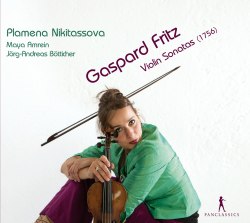| 
|
Gaspard FRITZ (1716-83)
Violin Sonatas, op.3 (1756)
Sonata in D, op.3 no.1 [16:24]
Sonata in A, op.3 no.2 [14:27]
Sonata in C, op.3 no.3 [14:28]
Sonata in E flat, op.3 no.4 [14:16]
Sonata in B, op.3 no.5 [12:32]
Plamena Nikitassova (violin)
Maya Amrein (continuo cello), Jörg-Andreas Bötticher (continuo harpsichord)
rec. Roman Catholic Church, Nuglar-St Pantaleon, Switzerland, 5-8 February 2013.
PAN CLASSICS PC10295 [72:07]
This disc makes an excellent companion to the set of Fritz's Sinfonias released on CPO last year (777 696-2, review). Both bring well-merited exposure to yet another unjustly neglected composer - "one of the better-known unknowns", according to the accompanying booklet notes - of the eighteenth century. Swiss violinist-composer Fritz's Sonatas were published in Paris in 1756 as op.3, then again as op.2 in London in 1764.
Plamena Nikitassova, curiously looking as though she has been impaled by a giant bow on the front cover, plays Fritz's cosmopolitan, often virtuosic works with elegance and brilliance, ornamenting imaginatively. A former pupil of arguably Switzerland's greatest Baroque violinist, Chiara Banchini, she reiterates the successes of her recent recording of Fritz's contemporary Carlo Zuccari's Sonatas (Pan Classics PC10268).
On that recording as here Nikitassova is sensitively accompanied by experienced harpsichordist Jörg-Andreas Bötticher with further colourings from Maya Amrein's cello. Amrein can also be heard, incidentally, on another commendable recording of Fritz, his (original) op.2 Sonatas, performed on the flute and released by another Swiss label, Guild (GMCD7330, review).
On the present recording, all three artists use delightful-sounding period instruments. Pan's sound quality is warm and intimate, the violinist sensibly placed slightly forward of the continuos. Nikitassova's inhalations are annoyingly noisy at the beginning of some movements, and occasionally elsewhere - most noticeably in the first and final minute, for solo violin only, of the innovative last movement of Sonata no.4. The engineer might well be blamed, but violinists surely realise that any stertorous affectations are going to be picked up and enshrined forever. Still, a greater irritation for the listener is the frankly barmy absence of Sonata no.6, of which indeed no mention is made in the booklet: this really ought to have been a double-disc set. Anselm Hartinger's trilingual notes are exemplary in their intelligence, information content and style.
Byzantion
Contact at artmusicreviews.co.uk
 |
 |
|
